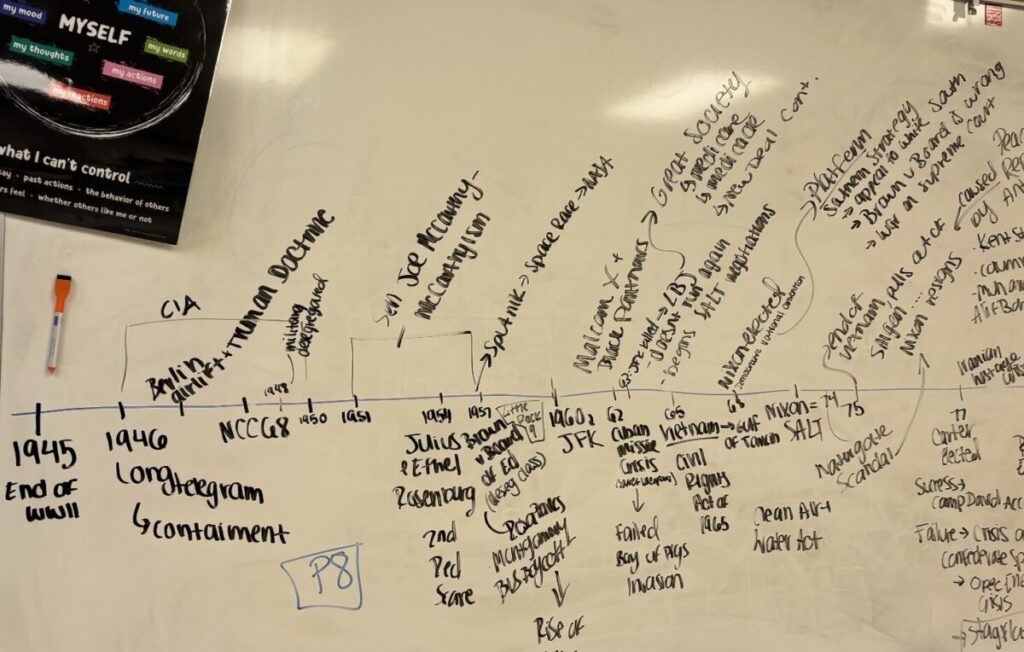Alessandra Gass, Editor-in-Chief
@agasscourant
As a seasoned student of the College Board’s Advanced Placement (AP) history curriculum, I’ve successfully navigated World History in 10th grade and dual enrollment in both United States and European History in 11th grade, with plans to complete my AP history journey by taking Comparative Government and Politics this upcoming year. However, these classes can be quite challenging, especially when attempting to study the intricacies of such broad topics. After trial and tribulation throughout my Junior year trying to balance US and European History, I believe I have cracked the code of success in these classes, which I plan to share with this series of AP history guides. First up: AP United States History, typically referred to as APUSH.
The APUSH course is designed to provide high school students a comprehensive understanding of American history, from before Columbus’ landing in the Americas to present-day geopolitical standings. By the end of this guide, you’ll be equipped with the knowledge, skills, and confidence needed to excel in your APUSH class and ace the AP exam!
First, a breakdown of the curriculum:
| Chronological Period | Description |
| Period 1: 1491-1607 Native American Societies and Exploration (4% – 6% of AP Exam) | – Native American societies before European contact – European exploration in the New World – The Columbian Exchange – Labor, slavery, and caste in the Spanish colonial system – Cultural interactions between Europeans, Native Americans, and Africans |
| Period 2: 1607 – 1754 Colonies established in New World by Dutch, French, Spanish, British (6% – 8% of AP Exam) | – How different European colonies developed and expanded – Transatlantic trade – Slavery in the British colonies – Interactions between American Indians and Europeans – Colonial society and culture |
| Period 3: 1754 – 1800 Events that led to the American Revolution, the formation of the US and its early years (10% – 17% of AP Exam) | – The Seven Years’ War – The American Revolution – The Articles of Confederation – The creation and ratification of the Constitution – Developing an American identity – Immigration to and migration within America |
| Period 4: 1800 – 1848 How the US developed politically, culturally, economically (10% – 17% of AP Exam) | – The rise of political parties – American foreign policy – Debates about federal power – The Second Great Awakening – The experience of African Americans – Reform Movements – Innovations in technology, agriculture, and business |
| Period 5: 1844 – 1877 Expansion of the Nation and the events leading to Southern Secession and the Civil War (10% – 17% of AP Exam) | – Manifest Destiny – The Mexican–American War – The Civil War – Reconstruction – Attempts to resolve conflicts over the spread of slavery – The election of 1860 and Southern secession |
| Period 6: 1865 – 1898 Economic and demographic shifts & link to change (10% – 17% of AP Exam) | – The settlement of the West – The “New South” – The rise of industrial capitalism – Immigration and migration – Reform movements -Gilded Age – Debates about the role of government |
| Period 7: 1890 – 1945 Changing societies, cause/effect of global wars & economic meltdown (10% – 17% of AP Exam) | – Debates over imperialism – The Progressive movement – World War I & II – Postwar diplomacy – Innovations in communications and technology in the 1920s – The Great Depression and the New Deal |
| Period 8: 1945 – 1980 Soviet Rivalry & growth of Civil Rights Movements (10% – 17% of AP Exam) | – The Cold War and the Red Scare – America as a world power – The Vietnam War – The Great Society – The African American civil rights movement – Youth culture of the 1960s |
| Period 9: 1980 – Present Political conservatism, dev in science and technology, demographic shifts (4% – 6% of AP Exam) | – Reagan and conservatism – The end of the Cold War – Shifts in the economy – Migration and immigration – Challenges of the 21st century |
Course Overview
The course is organized into nine distinct historical periods, each focusing on specific themes and concepts (seen above). While each section should be covered equally in your class, the beginning and final period will not be featured as heavily on your exam in May. Themes to know for each unit include national identity, work patterns, technology, geography and the environment, migration and settlement, politics and power, America in the world (exchange and politically), regional culture, and social structures. These are key concepts to understand, as the written portion of the exam will ask about one of these continuities, changes, causes, or effects.
Brief Period Overview
Now, I’ll walk you through each of these units from 3 perspectives: key elements, themes, and what you should take away. Before beginning the class in the fall, you should have relative understanding of each of these topics to make sure your learning is cohesive and does not lack a foundation. Remember that your exams throughout the year and final exam in May will rarely ask you a direct vocabulary term or definition of an event, but rather diverse factors and reactions to various movements or policies.
Period 1: Pre-Columbian Societies (before 1492)
Key elements: Indigenous societies, including the Mayan, Aztec, and Inca civilizations; Native American cultures in North America
Themes: Geography and environment, migration and settlement, social structures
What you should know: The diverse cultures, economies, and political structures of indigenous societies in the Americas before European contact
Period 2: Transatlantic Encounters and Colonial Beginnings (1492-1754)
Key elements: European exploration, the Columbian Exchange, the establishment of colonies, the Atlantic slave trade
Themes: American and national identity, work, exchange, and technology, politics and power
What you should know: The impact of European colonization on the Americas, the development of colonial societies, and the role of slavery in the early colonies
Period 3: Colonial North America (1754-1800)
Key elements: The French and Indian War, the American Revolution, the creation of the U.S. Constitution
Themes: American and national identity, politics and power, America in the world
What you should know: The causes and consequences of the American Revolution, the challenges of creating a new nation, and the formation of American political institutions
Period 4: The Early Republic (1800-1848)
Key elements: The War of 1812, westward expansion, the Second Great Awakening, the rise of sectionalism
Themes: Geography and environment, migration and settlement, social structures
What you should know: The growth and development of the United States, the impact of westward expansion on Native Americans, and the increasing tensions between the North and South
Period 5: The Growing Nation (1844-1877)
Key elements: The Mexican-American War, the Civil War, Reconstruction
Themes: American and national identity, politics and power, American and regional culture
What you should know: The causes and consequences of the Civil War, the challenges of Reconstruction, and the impact of these events on American society and politics
Period 6: Industrialization and Reform (1865-1914)
Key elements: The Gilded Age, the Progressive Era, imperialism
Themes: Work, exchange, and technology, politics and power, America in the world
What you should know: The impact of industrialization on American society, the efforts to address social and economic problems through reform movements, and the United States’ growing role in world affairs
Period 7: The Emergence of Modern America (1890-1930)
Key elements: World War I, the Roaring Twenties, the Harlem Renaissance
Themes: American and national identity, American and regional culture, social structures
What you should know: The United States’ involvement in World War I, the cultural and social changes of the 1920s, and the experiences of African Americans during this period
Period 8: The Great Depression and World War II (1929-1945)
Key elements: The Great Depression, the New Deal, World War II
Themes: Work, exchange, and technology, politics and power, America in the world
What you should know: The causes and effects of the Great Depression, the impact of the New Deal, and the United States’ role in World War II
Period 9: The Postwar United States (1945 to the present)
Key elements: The Cold War, the Civil Rights Movement, the Vietnam War, the rise of conservatism, globalization
Themes: American and national identity, politics and power, America in the world, social structures
What you should know: The United States’ role in the Cold War, the struggle for civil rights, the impact of the Vietnam War, and the challenges and opportunities of the late 20th and early 21st centuries
Resources
Obviously, you’ll need much more than just this guide for success in your APUSH class. While your teacher and textbook are a great place to start, it can be difficult to fully grasp the complexities of U.S. history without exploring additional resources and perspectives beyond the classroom. Below, I’ve listed some of my favorite outside resources that I can credit a majority of my success on in-class and AP exams.
Heimlers History on Youtube
If you’re taking an AP History course and have never watched a Heimler video, you’re going to have a very hard time grasping broader concepts and key intricacies. Heimler offers free, full-unit review videos in addition to shorter videos on each subunit. Heimler also offers an Ultimate Review Guide that costs roughly $20. Honestly, I have not found these review guides to be any more helpful than his free content, so I would recommend saving your money and sticking to his Youtube channel alone – your pocket and grades will thank you.

FIVEABLE
This past year, Fiveable Cram Guides were one of my most referenced resources when studying for exams. Fiveable offers individual written guides on each subunit, which is extremely helpful to a reading and writing learner like myself who finds taking notes the easiest way to retain information.
Crash Course on Youtube
While Crash Course does not offer videos specific to any AP history curriculum, they do have a plethora of videos on dozens of historical topics, ranging from the French Revolution to the Cold War. These videos are a great resource when you find yourself struggling with a specific topic or event, as each video is very thorough and engaging. For example, if you find yourself unable to understand triangular trade, their detailed video on the Columbian exchange would clear all your questions up.

In closing
Overall, don’t stress it too much! I took APUSH alongside AP European History this year, and found that studying the “right” things (cause and effect, continuities and change, influential figures and policies) and not getting caught up in intricate details saves time, boosts grades, and increases cohesive understanding. While it may take a few months to figure out what works best for you, your success in the class truly depends on finding the right study strategy. As I mentioned previously, I learn best through note taking. However, my biggest strategy this year and last was making timelines of my notes afterwards, pictured above. By applying your newfound knowledge and piecing it together in a chronological manner, your brain is able to develop an understanding of the content rather than a short-term memorization of remote terms. As long as you stay on top of your work, read your textbook and take beneficial notes, and remain attentive in class, success in APUSH should not be impossible. I wish you the best of luck!!




